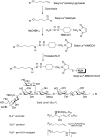Synthesis of sialyl Lewis(a) (sLe (a), CA19-9) and construction of an immunogenic sLe(a) vaccine
- PMID: 19190907
- PMCID: PMC2828770
- DOI: 10.1007/s00262-008-0654-7
Synthesis of sialyl Lewis(a) (sLe (a), CA19-9) and construction of an immunogenic sLe(a) vaccine
Abstract
Sialyl Lewis(a) (sLe(a)), also termed CA19-9 antigen, is recognized by murine mAb19-9 and is expressed on the cancer cell surface as a glycolipid and as an O-linked glycoprotein. It is highly expressed in a variety of gastrointestinal epithelial malignancies including colon cancer and pancreatic cancer, and in breast cancer and small cell lung cancer, but has a limited expression on normal tissues. sLe(a) is known to be the ligand for endothelial cell selectins suggesting a role for sLe(a) in cancer metastases and adhesion. For these reasons, sLe(a) may be a good target for antibody mediated immunotherapy including monoclonal antibodies and tumor vaccines. However, sLe(a) is structurally similar to sLe(x) and other blood group related carbohydrates which are widely expressed on polymorphonucleocytes and other circulating cells, raising concern that immunization against sLe(a) will induce antibodies reactive with these more widely expressed autoantigens. We have shown previously both in mice and in patients that conjugation of a variety of carbohydrate cancer antigen to keyhole limpet hemocyanin (KLH) and administration of this conjugate mixed with saponin adjuvants QS-21 or GPI-0100 are the most effective methods for induction of antibodies against these cancer antigens. We describe here for the first time the total synthesis of pentenyl glycoside of sLe(a) hexasaccharide and its conjugation to KLH to construct a sLe(a)-KLH conjugate. Groups of five mice were vaccinated subcutaneously four times over 6 weeks. Sera were tested against sLe(a)-HSA by ELISA and against sLe(a) positive human cell lines adenocarcinoma SW626 and small cell lung cancer (SCLC) DMS79 by FACS. As expected, mice immunized with unconjugated sLe(a) plus GPI-0100 or unconjugated sLe(a) mixed with KLH plus GPI-0100 failed to produce antibodies against sLe(a). However, mice immunized with sLe(a)-KLH conjugate without GPI-0100 produced low levels of antibodies and mice immunized with sLe(a)-KLH plus GPI-0100 produced significantly higher titer IgG and IgM antibodies against sLe(a) by ELISA. These antibodies were highly reactive by FACS and mediated potent complement mediated cytotoxicity against sLe(a) positive SW626 and DMS79 cells. They showed no detectable cross reactivity against a series of other blood group-related antigens, including Le(y), Le(x), and sLe(x) by dot blot immune staining. This vaccine is ready for testing as an active immunotherapy for treating sLe(a) positive cancer in clinical settings.
Figures





Similar articles
-
A preclinical study comparing approaches for augmenting the immunogenicity of a heptavalent KLH-conjugate vaccine against epithelial cancers.Cancer Immunol Immunother. 2003 Oct;52(10):608-16. doi: 10.1007/s00262-003-0399-2. Epub 2003 Jun 17. Cancer Immunol Immunother. 2003. PMID: 12811527 Free PMC article.
-
Constructing an adenocarcinoma vaccine: immunization of mice with synthetic KH-1 nonasaccharide stimulates anti-KH-1 and anti-Le(y) antibodies.Int J Cancer. 2002 May 10;99(2):207-12. doi: 10.1002/ijc.10305. Int J Cancer. 2002. PMID: 11979435
-
Immunization with N-propionyl polysialic acid-KLH conjugate in patients with small cell lung cancer is safe and induces IgM antibodies reactive with SCLC cells and bactericidal against group B meningococci.Cancer Immunol Immunother. 2012 Jan;61(1):9-18. doi: 10.1007/s00262-011-1083-6. Epub 2011 Aug 3. Cancer Immunol Immunother. 2012. PMID: 21811785 Free PMC article. Clinical Trial.
-
Ganglioside vaccines with emphasis on GM2.Semin Oncol. 1998 Dec;25(6):636-45. Semin Oncol. 1998. PMID: 9865678 Review.
-
Carbohydrate vaccines as immunotherapy for cancer.Immunol Cell Biol. 2005 Aug;83(4):418-28. doi: 10.1111/j.1440-1711.2005.01350.x. Immunol Cell Biol. 2005. PMID: 16033538 Review.
Cited by
-
Immunology in the clinic review series; focus on cancer: glycolipids as targets for tumour immunotherapy.Clin Exp Immunol. 2012 Feb;167(2):206-15. doi: 10.1111/j.1365-2249.2011.04516.x. Clin Exp Immunol. 2012. PMID: 22235996 Free PMC article. Review.
-
Synthesis and immunological evaluation of a MUC1 glycopeptide incorporated into l-rhamnose displaying liposomes.Bioconjug Chem. 2013 Mar 20;24(3):363-75. doi: 10.1021/bc300422a. Epub 2013 Mar 8. Bioconjug Chem. 2013. PMID: 23444835 Free PMC article.
-
Facile chemoenzymatic synthesis of Lewis a (Lea) antigen in gram-scale and sialyl Lewis a (sLea) antigens containing diverse sialic acid forms.Carbohydr Res. 2019 Jan 15;472:115-121. doi: 10.1016/j.carres.2018.12.004. Epub 2018 Dec 9. Carbohydr Res. 2019. PMID: 30562693 Free PMC article.
-
Targeting Tumor Glycans for Cancer Therapy: Successes, Limitations, and Perspectives.Cancers (Basel). 2022 Jan 27;14(3):645. doi: 10.3390/cancers14030645. Cancers (Basel). 2022. PMID: 35158915 Free PMC article. Review.
-
Therapeutic cancer vaccines.Adv Cancer Res. 2014;121:67-124. doi: 10.1016/B978-0-12-800249-0.00002-0. Adv Cancer Res. 2014. PMID: 24889529 Free PMC article. Review.
References
-
- Magnani JL, Nilsson B, Brockhaus M, et al. A monoclonal antibody-defined antigen associated with gastrointestinal cancer is a ganglioside containing sialylated lacto-N-fucopentaose II. J Biol Chem. 1982;257:14365–14369. - PubMed
-
- Nakamori S, Kameyama M, Imaoka S, et al. Increased expression of sialyl Lewis x antigen correlates with poor survival in patients with colorectal carcinoma: clinicopathological and immunohistochemical study. Cancer Res. 1993;53:3632–3637. - PubMed
Publication types
MeSH terms
Substances
Grants and funding
LinkOut - more resources
Full Text Sources
Other Literature Sources
Medical
Research Materials

